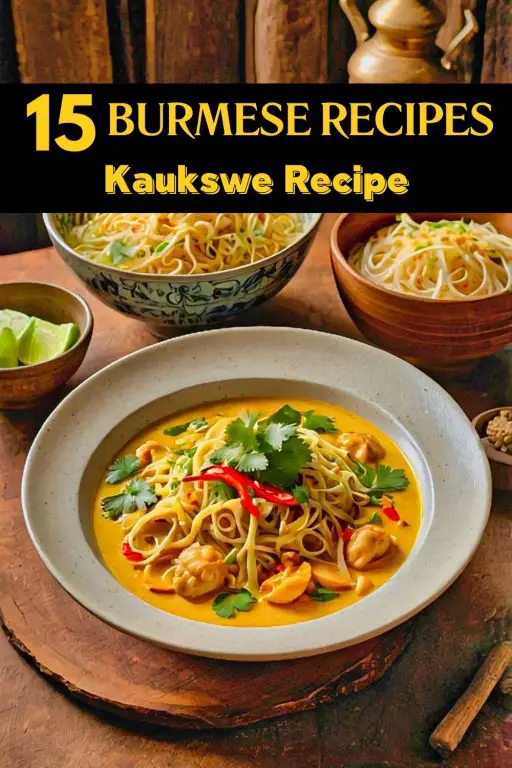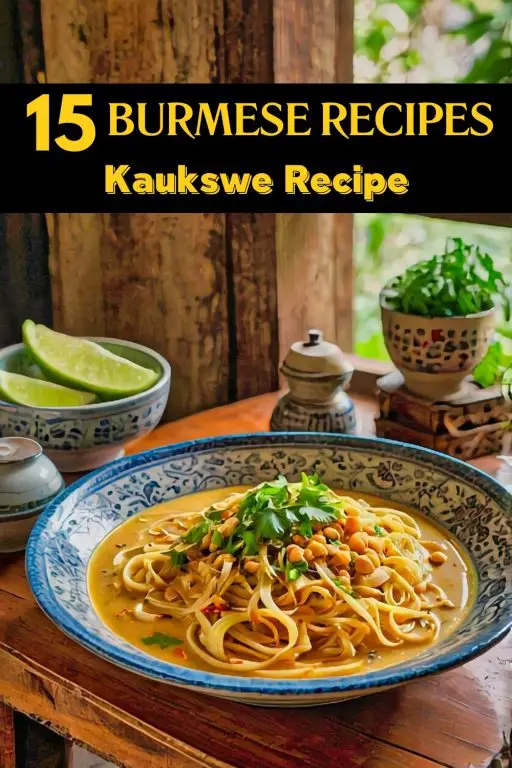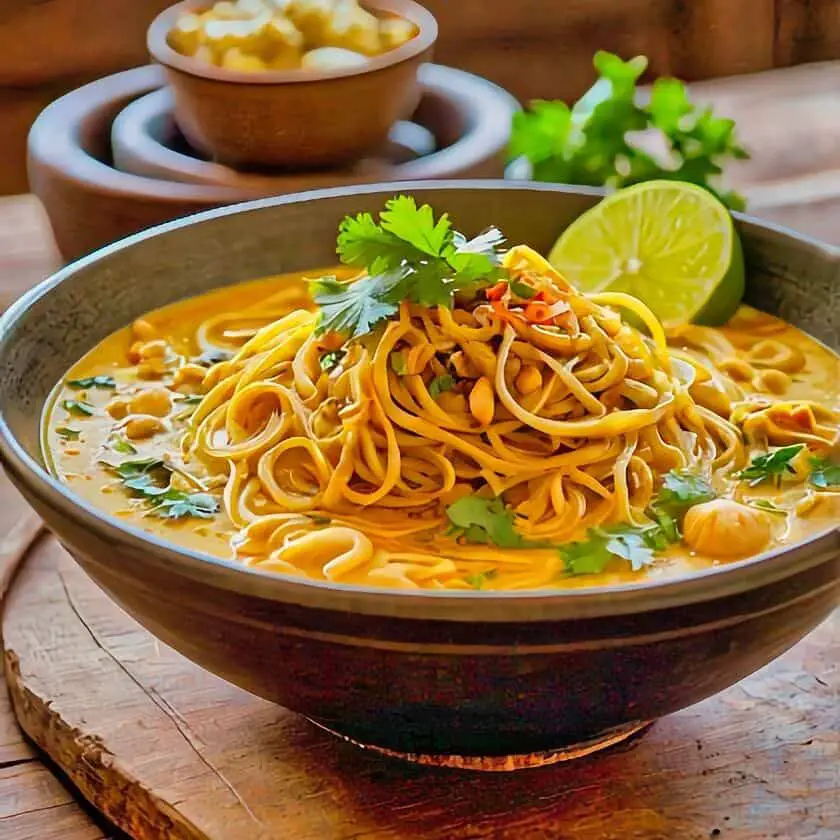The Burmese Kaukswe recipe was one of the best parts of my recent food adventures. While I was at a small, local restaurant, I got to try this dish and even got the recipe directly from the kitchen. The recipe for Burmese Kaukswe interested me because of its rich and creamy texture, which is made using a special cooking method. The main method is to cook the dish at a low and steady temperature. This technique makes the sauce thicker and gives it a smooth texture that covers the noodles just right.
The Burmese Kaukswe recipe is special because it combines rich and mild flavors in a really nice way. The slow cooking method helps the spices blend well together, creating a smooth texture in the dish. I saw that this way of cooking affects how the food feels in your mouth, making every bite both rich and light. I noticed that the method did a great job of controlling the thickness, making sure the sauce stayed perfect without being too thick or too watery. The focus on detail made the Burmese Kaukswe recipe a special part of my trip.
Experiencing it myself helped me understand the way of preparing it better, and I am looking forward to taking this new recipe home with me.
Ingredients For the Burmese Kaukswe Recipe
For the Noodles:
Fresh Egg Noodles
Vegetable Oil
Turmeric Powder
For the Soup
Vegetable Oil
Chopped Onion
Minced Garlic Cloves
Minced Ginger
Skinless Chicken Breast
Curry Powder
1 tsp Paprika
Coriander
Cumin
Cayenne Pepper
Chicken Stock
Coconut Milk
Fish Sauce
Soy Sauce
Salt
For the Toppings
Bean Sprouts
Shredded Cabbage
Sliced Onions
Sliced Green Onions
Chopped Cilantro
Lime Cut Into Wedges
Crispy Fried Noodles
Cooking Instructions Burmese Kaukswe Recipe
- Cook the noodles according to the package instructions. Drain and toss with 2 tbsp of vegetable oil and 1 tsp of turmeric powder. Set aside.
- Heat 2 tbsp of vegetable oil in a large pot over medium heat. Add the chopped onion, minced garlic, and minced ginger. Cook for 3-4 minutes, or until the onion is soft and translucent.
- Add the chicken to the pot and cook for 5-6 minutes, or until the chicken is no longer pink.
- Add the curry powder, paprika, coriander, cumin, and cayenne pepper to the pot. Stir well and cook for 1-2 minutes.
- Add the chicken stock, coconut milk, fish sauce, and soy sauce to the pot. Bring the soup to a simmer and cook for 10-15 minutes, or until the chicken is cooked through and the flavors have melded together.
- To serve, divide the noodles among 8 bowls. Ladle the soup over the noodles. Top with bean sprouts, shredded cabbage, sliced onions, sliced green onions, chopped cilantro, and crispy fried noodles or fried garlic. Serve with lime wedges on the side.
 Food Most Eaten by Locals in Burma
Food Most Eaten by Locals in Burma
In Burma, now officially known as Myanmar, the diet is deeply influenced by its rich cultural heritage and regional diversity. The Burmese diet is predominantly based on rice, which is the staple food, complemented by a variety of dishes that reflect the country’s diverse agricultural products and culinary traditions.
Rice is central to Burmese meals, served with a wide array of accompanying dishes. These side dishes, often referred to as “curry” or “thoke,” are essential to the Burmese dining experience. One of the most popular is Mohinga, a fish-based noodle soup considered the national dish. It features rice noodles in a broth made from fish, lemongrass, and a blend of spices, typically garnished with crispy fritters, boiled eggs, and fresh herbs. This dish showcases the Burmese preference for combining rice with aromatic and flavorful ingredients.
Another staple is Laphet, fermented tea leaves mixed with various ingredients such as nuts, seeds, and dried shrimp. This dish is often eaten as a salad or side, offering a unique taste profile with its tangy, slightly bitter flavour. Laphet reflects the Burmese love for pickled and fermented foods, which are common in many local diets.
Shan Noodles are another popular choice, originating from the Shan State in eastern Myanmar. This dish consists of rice noodles served with a spicy, savoury sauce made from tomatoes, garlic, and sometimes minced pork or chicken. It highlights the regional diversity in Burmese cuisine, with variations across different states and ethnic groups.
Vegetables and legumes also play a significant role in the Burmese diet. Kaukswe, a noodle dish cooked in coconut milk and accompanied by a mix of vegetables and sometimes chicken or pork, is a common meal. The use of coconut milk and a variety of fresh vegetables highlights the country’s abundant agricultural produce.
Burmese salads (known as “thoke”) come in various types, such as Tangy Green Papaya Salad and Chickpea Salad, and are typically made with fresh, local ingredients. These salads are usually tangy and spicy, with ingredients like lime juice, fish sauce, and chili peppers.
Meals are often accompanied by peyet (rice wine) or tea, reflecting the local drinking culture. In rural areas, traditional meals are more simple and rely heavily on local produce, while urban areas may offer more variety due to the influence of international cuisines and the availability of diverse ingredients.
Overall, the Burmese diet is a reflection of its rich cultural tapestry, combining rice with a variety of vegetables, meats, and unique regional flavors.
5 Essiential Ingredients for Cooking Burmese Style Food
Here are the top five essential ingredients for cooking Burmese-style food, detailed with their uses and significance:
1. Rice
Description: Rice is the fundamental staple of Burmese cuisine, reflecting its status as a primary food source across Myanmar. It is typically long-grain or jasmine rice, known for its slightly sticky texture when cooked.
Usage: Rice accompanies nearly every meal, serving as the base for curries, soups, and salads. It is essential in dishes like Mohinga, where it is sometimes added directly to the soup or served on the side. In addition to steamed rice, fried rice variations are also popular, often including vegetables, meats, and sometimes even seafood. Rice is versatile, used in both everyday meals and festive dishes.
2. Fish Sauce (Ngan Pya Yay)
Description: Fish sauce is a fermented condiment made from fish and salt. It has a pungent aroma but imparts a deep umami flavour that is crucial to many Burmese dishes. It is usually made from anchovies or other small fish and aged to develop its robust taste.
Usage: Fish sauce is used extensively to season soups, curries, and salads. In dishes like Laphet (fermented tea leaf salad), it adds a salty depth that balances the tangy and bitter notes of the tea leaves. It is also a key ingredient in many dipping sauces and marinades, contributing to the complex flavour profiles typical of Burmese cuisine.
3. Lemongrass
Description: Lemongrass is a fragrant herb with a citrusy, slightly floral flavour. Its stalks are used in cooking, providing a bright, fresh aroma and taste. In Burmese cuisine, it is used both for its flavour and for its fragrant qualities.
Usage: Lemongrass is commonly added to broths and soups, such as Mohinga, to impart a distinctive lemony taste. It is also used in marinades for meat and fish, and in curries to enhance the overall flavour profile. Lemongrass is typically cut into pieces or bruised to release its essential oils, infusing dishes with its aromatic essence.
4. Ginger
Description: Ginger is a spicy, aromatic root widely used in Burmese cooking. It adds warmth and depth to dishes, with a flavour that is both sharp and sweet. Fresh ginger is preferred, though dried or powdered ginger is also used in some recipes.
Usage: Fresh ginger is often combined with garlic to form a flavour base for many Burmese dishes. It is used in curries, soups like Kaukswe (coconut noodle soup), and stir-fries. Ginger’s warming spice complements the complex flavours of Burmese cuisine, balancing out richer elements and enhancing the overall taste.
5. Turmeric
Description: Turmeric is a bright yellow spice known for its earthy, slightly bitter flavour and vibrant colour. It contains curcumin, which is responsible for its distinctive hue and is celebrated for its health benefits.
Usage: Turmeric is integral in many Burmese curries and stews, where it imparts a rich golden colour and an earthy flavour. It is often used in combination with other spices to create the complex flavour profiles typical of Burmese curries. Turmeric is also used in rice dishes and some soups to add both colour and flavour. Its presence is key to achieving the characteristic appearance and taste of traditional Burmese dishes.
Each of these ingredients plays a crucial role in defining the unique flavours of Burmese cuisine, contributing to the rich and varied taste experiences that characterise Myanmar’s culinary traditions.
 FAQ For the Burmese Kaukswe Recipe
FAQ For the Burmese Kaukswe Recipe
What ingredients are typically used in a Burmese Kaukswe recipe?
A traditional Burmese Kaukswe recipe usually includes a mix of ingredients like coconut milk, chicken or beef, onions, garlic, turmeric, and gram flour to form a creamy curry base. The noodles are typically egg noodles, and the dish is garnished with toppings such as crispy fried onions, boiled eggs, and fresh lime wedges. Depending on personal preference, the dish can be customized with a variety of condiments like fish sauce, chili oil, or fresh coriander.
How spicy is a traditional Burmese Kaukswe recipe?
The spice level in a Burmese Kaukswe recipe can vary greatly depending on the amount of chili paste or fresh chilies added. Traditionally, the dish has a mild base with coconut milk balancing out the spices, but heat can be easily adjusted by adding more chili oil or fried chili flakes. For those who prefer a milder taste, reducing the chili while maintaining the other rich flavors will still provide a satisfying experience.
Can a Burmese Kaukswe recipe be made vegetarian or vegan?
Yes, a Burmese Kaukswe recipe can be easily adapted to suit a vegetarian or vegan diet by replacing the meat with tofu or a mix of vegetables like mushrooms, zucchini, and carrots. You can also substitute fish sauce with soy sauce or a vegan fish sauce alternative to maintain the depth of flavor. The rich coconut milk base remains the same, making the dish just as creamy and flavorful even without animal products.
What makes a Burmese Kaukswe recipe unique compared to other noodle dishes?
A Burmese Kaukswe recipe stands out because of its rich and creamy coconut milk-based curry, which is poured over noodles and then garnished with a variety of textures and flavors. Unlike other noodle dishes that may focus on a broth or stir-fry base, Kaukswe combines elements of curry and soup with customizable toppings such as fried onions, boiled eggs, and lime for freshness. The blend of Southeast Asian and Indian influences in the spice mix also adds a unique depth to the dish.
How long does it take to prepare a Burmese Kaukswe recipe?
Preparing a Burmese Kaukswe recipe typically takes around 45 minutes to an hour, depending on the complexity of the toppings and garnishes. Cooking the curry base is relatively straightforward, but preparing the accompaniments like fried onions, boiled eggs, and noodles can add a bit of extra time. Despite the multiple components, the dish is worth the effort, as the combination of rich, creamy curry with various toppings makes for a satisfying meal.

Burmese Kaukswe Recipe
Ingredients
- 1 lb. fresh egg noodles or dried egg noodles
- 2 tbsp vegetable oil
- 1 tsp turmeric powder
- 2 tbsp. vegetable oil
- 1 onion, chopped
- 3 garlic cloves, minced
- 1 inch ginger, minced
- 1 lb. boneless, skinless chicken breast, cut into small pieces
- 2 tbsp. curry powder
- 1 tsp paprika
- 1 tsp ground coriander
- 1 tsp cumin
- ¼ tsp cayenne pepper
- 4 cups chicken stock
- 1 14 ounce can coconut milk
- 1 tbsp. fish sauce
- 1 tbsp. soy sauce
- Salt, to taste
- 2 cups bean sprouts
- 2 cups shredded cabbage
- 2 cups sliced onions
- 1 cup sliced green onions
- 1 cup chopped cilantro
- 1 lime, cut into wedges
- 1 cup crispy fried noodles or fried garlic
Equipment
- Large pot for cooking the soup
- Large pot for cooking the noodles
- Strainer for draining the noodles
- Cutting board and knife for chopping the vegetables
- Measuring cups and spoons
- Mixing Bowls
- serving bowls
- Ladle for serving
Instructions
- Cook the noodles according to the package instructions. Drain and toss with 2 tbsp of vegetable oil and 1 tsp of turmeric powder. Set aside.
- Heat 2 tbsp of vegetable oil in a large pot over medium heat. Add the chopped onion, minced garlic, and minced ginger. Cook for 3-4 minutes, or until the onion is soft and translucent.
- Add the chicken to the pot and cook for 5-6 minutes, or until the chicken is no longer pink.
- Add the curry powder, paprika, coriander, cumin, and cayenne pepper to the pot. Stir well and cook for 1-2 minutes.
- Add the chicken stock, coconut milk, fish sauce, and soy sauce to the pot. Bring the soup to a simmer and cook for 10-15 minutes, or until the chicken is cooked through and the flavors have melded together.
- To serve, divide the noodles among 8 bowls. Ladle the soup over the noodles. Top with bean sprouts, shredded cabbage, sliced onions, sliced green onions, chopped cilantro, and crispy fried noodles or fried garlic. Serve with lime wedges on the side.



3 comments
This recipe exceeded all my expectations—absolutely delicious!
I cant believe they didnt mention the importance of using fresh coconut milk in the Burmese Kaukswe recipe! Its a game-changer and really elevates the dish. Whos with me on this?
I cant believe they didnt mention the secret spice blend that makes Burmese Kaukswe so unique! Its like leaving out the best part of the recipe. What a missed opportunity!
Comments are closed.